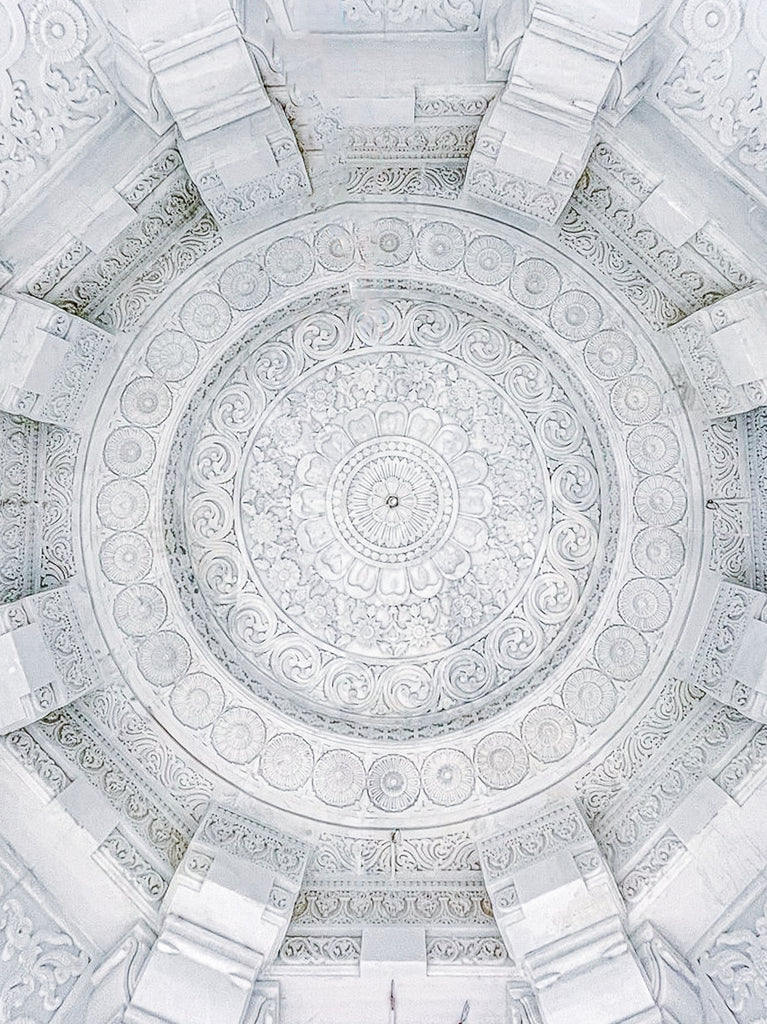Right before the Ram Mandir was opened up for visits, stonecrafters at a marble factory in Makrana worked round-the-clock. After all, the deadline to finish the inlay work and carving for the Garbhagriha or sanctum sanctorum of the Ram Temple in Ayodhya was near.
They carved ashtakamal (eight-petalled lotus) creepers and flower garlands onto 15,000 square feet of pristine white marble mined from Makrana, a town deep within Rajasthan or the land of kings.
The Significance of the Garbhagriha in the Ram Mandir
In Hindu temple architecture, the Garbhagriha, or the space where the deity resides, is considered the heart of the temple. It represents the divine energy of the deity. Inevitably, the choice of materials and the craftsmanship that goes into creating this sacred space are crucial, symbolizing the devotion and reverence of the worshippers.
The Garbhagriha of the Ram Mandir, thus, is more than just the sanctum sanctorum; it is a symbol of devotion, cultural revival, and spiritual awakening. The choice of Makrana marble for this sacred space is a deliberate nod to tradition and an acknowledgment of the enduring beauty and purity associated with this remarkable stone.
The meticulous process of adorning the Garbhagriha began with the selection of the finest Makrana marble slabs. Artisans, often hailing from generations of skilled craftsmen in Makrana, employed traditional techniques to shape and carve the marble into intricate designs. Every stroke and chisel reflects a profound devotion to both the craft and the spiritual essence embodied in the temple.
Why The Sompura Community Prefers Makrana Marble
Ashish Sompura, the chief architect of the Ram Mandir, told The Times of India that only Indian marble has been used in the inner sanctum of the temple. And, no imported marbles, even coloured ones have been used for the space.
Ashish belongs to the Sompura Salat, a Brahmin community renowned for their expertise in temple architecture. For them, the stone they conceptualize sacred spaces with takes a spiritual form.
Their preference for the Makrana marble is not just aesthetic – the marble has two vital attributes that align perfectly with their sacred endeavors. In the words of another member of the Sompura community, “Makrana marble doesn’t absorb external impurities. In this way, the marble is a reflection of our own striving to withstand and resist the impurities of the external world. Compared with other marble, Makrana marble will look exactly the same after a thousand years.”
While 16 mm marble slabs are used for regular construction, 40 mm slabs have been used in the Ram temple to ensure that the temple lasts a lifetime, and then some.
Thus, when these artisans combine their skills with the marble; it becomes a symphony in stone, an ode to devotion and artistry.
Why Makrana Marble is Perfect For This
Makrana marble becomes the perfect canvas for expressing this sacred connection. The pure white hue of the Makrana marble is seen as symbolic of Lord Rama's divine presence, radiating positive energy and creating an atmosphere of serenity and spiritual purity within the Garbhagraha.
The preference for this stone extends beyond artists to the intricate realm of Vastu Shastra, the ancient Indian science of architecture and design. Vastu experts have consistently recommended Makrana marble for its perceived positive energy, historical significance, and unparalleled beauty.
Read more about this, here.
The timeless attributes of the marble make possible three unique designs: ‘Jaali,’ ‘Carving,’ and ‘Inlay’ or Parchin Kari.
Jaali: The Ustajis have perfected the art of Jaalis or perforated stones and latticed screens on Makrana marble over centuries. This net-like design, used in ancient Indian sanctuaries dedicated to Buddhism, Jainism, and Hinduism, controlled lighting and created an atmosphere conducive to worship.
Carving: Also known as ‘Gadhai,’ this foundational technique depicts mythological scenes, floral patterns, and geometric designs on marble. The Garbhagriha of the Ram temple in Ayodhya narrates tales of devotion through intricate carvings on Makrana marble.
Inlay: Makrana marble finds enchanting applications in Pietra Dura, or Parchin Kari in the Indian subcontinent. This decorative art form utilizes mosaic techniques to inlay marble and other precious stones, creating intricate images and patterns. The echoes of Makrana marble in Pietra Dura resonate with the exquisite inlay work seen in the Taj Mahal, showcasing its enduring significance in the world of art.
As the inlay work for the Ram temple nears completion at the Makrana factory, each piece of marble destined for the temple becomes not just a building material but a carrier of centuries-old craftsmanship, a conduit for divine energy, and a symbol of the enduring spirit of Ayodhya.
Not Just in Ram Mandir – Where Else Has Makrana Marble Been Used?
Makrana, renowned for its quarries that have produced marble for centuries, holds a unique position in the world of architectural and artistic marvels.
The marble from this region has left an indelible mark on some of the most iconic structures globally, including the Taj Mahal. In fact, this exquisite stone has also been used in the Victoria Memorial, the Golden Temple, the Birla Temple, and the ISKCON temple in Ahmedabad.
How We Use Makrana Marble To Craft Timeless Home Temples
At Shwet, all home temples are built with Makrana marble too. Our logo, a beautiful white peacock, aligns with the purity of the sacred stone and principles from the Vastu Shastras. The peacock’s gaze is set to the north east, contemplating the Vastu of the temple, while its feet are placed inside the auspicious chhokhat. The lamp-like ‘t’ symbolizes both the flame of the law and the lamps integral to puja ritual.
Our commitment to timeless philosophy is not confined to the past; it thrives vibrantly in the present. While our devotional items are crafted with meticulous hand-carving, the contemporary spirit finds expression in the details. With this philosophy in mind, we offer the following designs:
Classic: Shwet's classic collection comprises fifteen designs meticulously crafted by master artisans. Ranging from traditional to contemporary, these designs incorporate revered symbols of faith. Mindful sizing caters to different living spaces, with most falling between two-and-a-half to four feet, providing an excellent starting point for customization.
Personalized: The personalized collection allows for nuanced modifications, catering to individual preferences and spatial requirements. Adjustments in measurements ensure a precise fit in any nook or alcove, transforming spaces into beautiful puja areas. Personal touches extend to the design itself, enabling emphasis on a particular deity or symbol.
You can take a look at all our work here.

















